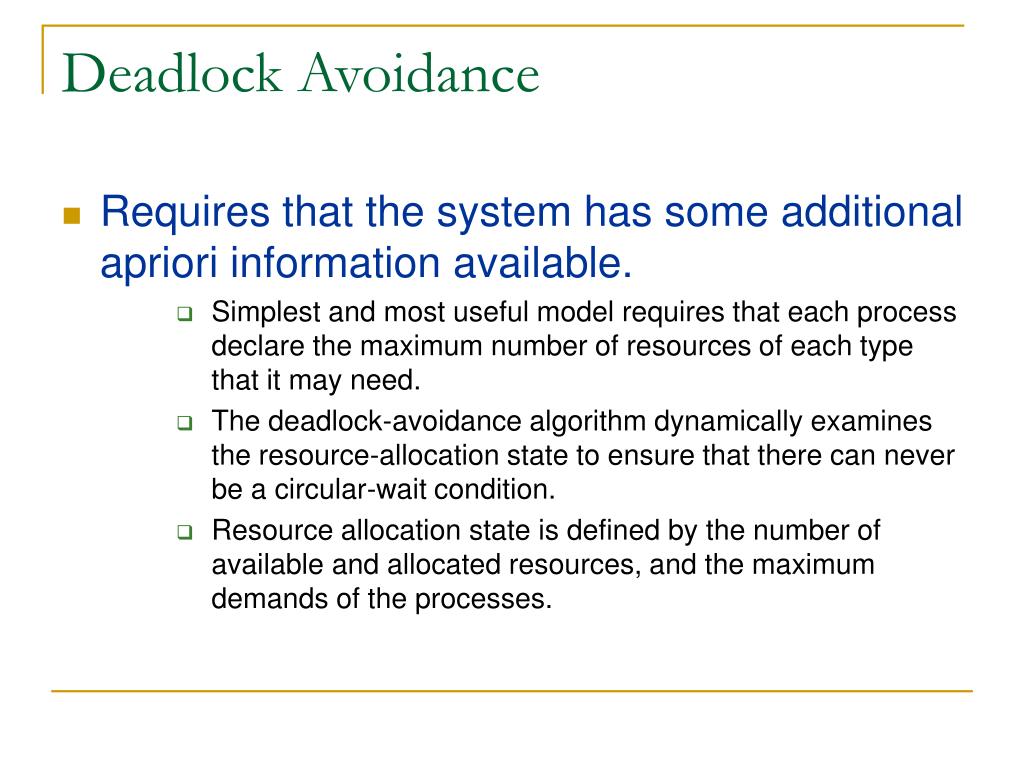
Upper Saddle River, NJ: Pearson Education, Inc. Modern Operating Systems, Fourth Edition. Then Job A would request and hold all of their tools again until all of them are available. Since Job B was already holding Tool 2 and requesting Tool 1 they would have gotten it to complete their job. With the Hold and Wait deadlock avoidance in place, in the introduction example, Job A would have held Tool 1 and waited for Tool 2. In this way, threads will sequence through a critical region in priority-order." When the thread unlocks the mutex, the highest-priority thread waiting to lock the mutex will unblock and become the new owner of the mutex. Threads attempting to lock an already locked mutex will block until the thread that owns the mutex unlocks it. QNX, a subsidiary of Black Berry says, " Only one thread may have the mutex locked at any given time. Then the process of locking the needed threads can start over. Holding and locking threads one-by-one for a predetermined amount of time will stop the deadlock from happening because those threads will be released if the rest aren't available and locked within that time period. However, if the currently locked threads are in the mutex knowing that all threads are available then the process will finish, unlock, and make those threads available to other processes that need to be executed. Once a thread is locked into a mutex it cannot be used elsewhere creating the opportunity for deadlocks. As threads enter the mutex they are locked (pthread_mutex_lock()) and when they exit the mutex they are unlocked (pthread_mutex_unlock()). There might be one of five threads always being used by another process and never actually have all five available at the same time. Waiting for every necessary thread to be available before locking them in the mutex can be problematic because the amount of time is unknown and could actually be infinite. There are a few ways to solve the problem but some of the solutions create new problems as well. algorithm is incorporated with a deadlock avoidance mechanism 8. Perhaps Job A has held 3 of 4 tools needed for the job for 10 minutes, so the algorithm can now release them back to the shelf before the deadlock occurs. tributed systems, many SS distributed mutual exclusion. Another way to avoid the deadlock would be to grab the tools and parts one-by-one, but release them back if a duration of time has gone by.

For example, Job A above wouldn't have grabbed Tool 1 until all of the necessary tools and parts were available, then it would grab all of them together. Luckily, there are algorithms that avoid deadlocks by initially waiting for all of the threads to be available before beginning the process. Sometimes processes need the same threads that are never going to be available because neither process has all of the required threads to execute. That analogy relates to processes requesting threads to complete the entire process. Both Job A and Job B are now in wait mode for another tool in which neither of them can get. Job A gets a hold of Tool 1 and requests Tool 2, however Job B already got a hold of Tool 2 and requests Tool 1. For example, two production employees start Job A and Job B that both require Tool 1 and Tool 2. Deadlocks happen when servers are busy processing multiple programs at the same time and when certain programs request the same threads. Written by: Chris Bell - December, 2015 Operating Systems Deadlock Avoidance | Processes and Threadsĭeadlock avoidance is important for TSI to configure so that their server can operate 24 hours per day, and so that customers can always access the website to make purchases during peak periods. So, in that situation, we use the Banker’s algorithm to determine the deadlock.About Me > Master's Degree > IT-600 - Operating Systems There will be the possibility of forming the circle, but it may lead to a deadlock. If there is more than one instance of a resource, it’ll not be certain in determining the deadlock. There is a limitation with the RAG algorithm that it’ll only work if all the resources have a single instance. Mostly, we represent vertices with a rectangular shape and edges with a circular shape: RAG has two vertices: process vertex and resource vertex, and two edges: assignment edge and request edge. Thus, we can easily avoid the deadlock.Īs every graph has vertices and edges, in the same way, RAG also has vertices and edges. We can figure out how many resources are allocated to each process and how many resources will be needed in the future. The resource allocation graph is the pictorial view of all allocated resources, available resources, and OS’s current state.



Using RAG, it’s possible to predict the occurrence of deadlock in an OS.


 0 kommentar(er)
0 kommentar(er)
